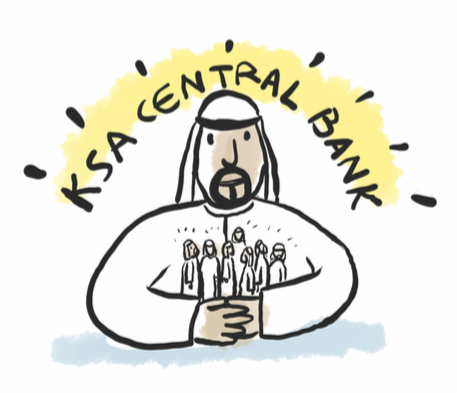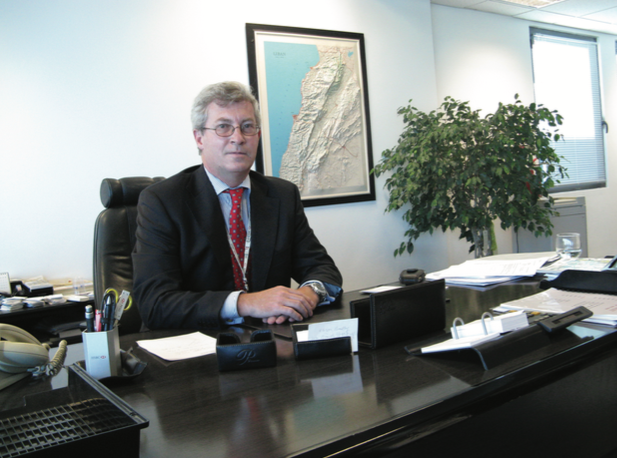The ongoing global financial crisis has had limited effects on the Saudi banking sector. Fighting through recent years — with the 2006 stock market crash and a bullish year in 2007 — Saudi banks in 2008 have “performed relatively well,” noted Murad Ansari, vice president at EFG-Hermes KSA. Saudi banks are not immune to the global troubles, but they are definitely less exposed than other banks around the world, especially since “almost 86% of total assets of the banking sector are invested in domestic assets,” as described in a recent EFG-Hermes report.
Due to their low exposure to international credit, equity, and property markets, Saudi banks have been able to insulate themselves from the storm of the international crisis. And thus, according to EFG-Hermes, “Saudi banks are relatively well positioned to weather the impact of the ongoing financial turmoil.” Also sheltering Saudi banks from the global chaos is the minimal exposure they have to equities and real estate. “Over the last 12 months,” contends EFG-Hermes, “rising cash reserve requirements of the central bank coupled with strong loan growth has meant that most of the banks have reduced their exposure to international assets.”
While most of the top banks reported mixed quarterly results, “overall the listed Saudi banks (nine month profitability) recorded [a year-on-year] increase of 1.6%”, said Global Investment House. The Saudi central bank has voiced willingness to help the kingdom’s banks if necessary, by injecting a proposed $40 billion of liquidity into the financial institutions. As of now, the central bank is yet to pour funds into the banking sector but, theoretically, by pumping liquidity into the banks, the central bank could buffer the consequences created by the financial distress, whilst guaranteeing bank deposits to boost confidence levels. Nonetheless, EFG-Hermes disclosed, “the central bank has lowered the cash reserve requirements of commercial banks by 300 basis points, freeing up an estimated SAR10 billion [$2.7 billion] in liquidity that had been with the central bank in cash reserves.”
What crisis?
According to Ansari, even though the growth rates in neighboring countries, such as the UAE and Qatar, have surpassed those of the kingdom, the balance sheets of Saudi Arabia’s banks have grown at an impressive 28% thus far this year. Third quarter results for 2008 show that the crisis has only affected selected banks and not the system in its entirety. EFG-Hermes also asserted, “Banks which had relatively higher asset exposure to North America and had higher investment equities have seen the impact in their 3Q 2008 results. However, even in [those cases], the impact has not been significant enough to wipe out profits.” Thus, even with a few dips in some banks’ profitability, such occurrences were not significant enough to lower confidence levels across the sector.
EFG-Hermes indicated a couple of “medium term challenges” confronting the Saudi banking sector. First and foremost, Saudi banks will have to face “arranging required funding to finance the aggressive domestic investment plan.” Secondly, they will have to figure out “funding to smaller corporate clients/sole proprietorships where owners can potentially have exposure to international equity markets.” However, such obstacles are not believed to be strong enough to weigh down earnings in the form of credit provisions for the sector.
The pivotal drivers of banking sector growth, as outlined by Ansari, are the corporate credit demand, an increase in government spending as well as expansions by large corporations and a surge in the demand from smaller corporations. The liquidity of the Saudi banking sector has also helped it stay afloat and perform decently. Hamad Saud Al Sayari, governor of the Saudi central bank, concurred, saying that the local banks are “highly liquid” and possess “good capital adequacy.” The total deposit growth by the third quarter of this year “surged by 9% [quarter-on-quarter] compared to 1% in [the second quarter of 2008] despite the fears of an outflow of funds following reduced speculation on the de-pegging of the Saudi Riyal to the US Dollar,” EFG-Hermes observed.
Forecasts
For the most part, the Saudi banking sector is predicted to slow in 2009. Ansari feels there are two sides to the story in 2009, assets and liabilities. Believing banks should be “extra cautious” now on the asset side, the VP outlined that the “financial viability of projects, and hence asset quality, will once again become the prime concerns for banks.” In terms of liabilities, banks are likely to seek new options to raise funds, and thus deposit mobilization will be a chief concern for the kingdom’s banking sector next year. Although such issues were present in 2008, Ansari reckoned that their relative importance in 2009 is “likely to increase significantly.” Overall, even at a slower pace, the Saudi banking sector is predicted to perform well next year. While the kingdom’s banks are not likely to face a “total meltdown,” Ansari feels that “the overall environment requires banks to be more prudent while lending.”









